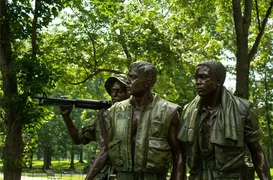National World War Ii Memorial

National World War Ii Memorial Reviews
Popular places near National World War Ii Memorial
FAQs about National World War Ii Memorial
When was the National World War II Memorial built?
When was the National World War II Memorial built?
Who designed the National World War II Memorial?
Who designed the National World War II Memorial?
How much does it cost to go to the National World War II Memorial?
How much does it cost to go to the National World War II Memorial?
Where is the National World War II Memorial?
Where is the National World War II Memorial?
What is the most famous WWII memorial?
What is the most famous WWII memorial?
What to know about National World War Ii Memorial
What to see at the National World War II Memorial
Freedom Wall
Feel the deep emotions stirred by the Freedom Wall, a touching tribute to the 405,000 American lives lost in the Second World War. Covered in 4,048 gold stars, with each star representing 100 fallen servicemen, this wall stands as a strong reminder of the immense sacrifices made for freedom. As you gaze upon this vast display of stars, pause to read the words "Here we mark the price of freedom" and pay respect to the courage, commitment, and American national unity of those who made the ultimate sacrifice.
Victory Pavilion
Victory Pavilion is a celebration of triumph and the end of tyranny. This must-visit site within the memorial is a testament to the hard-won peace and the global impact of the Allied victory. As you explore, you'll find massive bronze sculptures of eagles laying laurel wreaths, symbolizing victory and honor. The pavilion's pools list the names of key campaigns and battles, offering a deeper understanding of the monumental efforts that led to victory.
Granite Pillars and Bronze Wreaths
Experience the powerful symbolism of unity at the Granite Pillars and Bronze Wreaths. With 56 granite pillars, each inscribed with the name of a U.S. state or territory, this feature of the memorial represents the collective strength and solidarity of the nation during World War II. The bronze laurel wreaths adorning each pillar add a touch of elegance and honor, making this a must-see for anyone visiting the memorial.
Battle Inscriptions
Make sure not to miss the two hidden inscriptions at the memorial that say "Kilroy was here." This saying was a special symbol for American soldiers and armed forces during World War II and was scribbled with a little doodle at many places they visited during the war.
Atlantic and Pacific Arches
As you enter the memorial's curved area from the east, don't miss the two walls on either side of you. They showcase scenes from World War II in stunning bronze artwork. On the left side (towards the Pacific Arch), you'll see scenes that tell the story of the war, starting from physical exams and ending with soldiers returning home. The right side of the Atlantic and Pacific Theaters honors the Atlantic, with the final scene showing American and Russian troops shaking hands in Germany at the end of the war.
Tips for Your National World War II Memorial Visit
When is the best time to visit the National World War II Memorial?
The National World War II Memorial, protected by the National Park Service, is open 24/7, allowing for flexible visiting hours. For a more peaceful experience, consider visiting early in the morning or late in the evening. The lighting at night beautifully highlights the memorial's features, offering a unique and dramatic view.
How to get to the National World War II Memorial?
Reaching the National World War II Memorial is convenient with public transportation. The Smithsonian Metro station, accessible via the Orange, Blue, and Silver lines, is the closest stop. Additionally, several bus routes service the area, making it easy to include the World War 2 monument in your National Mall itinerary. Nearby, you can also visit the Washington Monument, the Lincoln Memorial, and more historical landmarks in Washington.
Explore more on Klook
Top attractions in Washington DC
- 1 The White House
- 2 Washington Monument
- 3 White House Visitor Center
- 4 International Spy Museum
- 5 Lincoln Memorial
- 6 Vietnam Veterans Memorial
- 7 Smithsonian National Museum of Natural History
- 8 National Mall
- 9 U.S. Capitol
- 10 Thomas Jefferson Memorial
- 11 National Aquarium
- 12 Basilica of the National Shrine of the Immaculate Conception
- 13 Smithsonian's National Postal Museum
- 14 Korean War Veterans Memorial
- 15 Capitol Hill
- 16 Hillwood Estate, Museum & Gardens
- 17 Ford's Theatre
- 18 Peace Monument
- 19 Washington National Cathedral
Top destinations in United States
- 1 Los Angeles
- 2 New York
- 3 Orlando
- 4 Las Vegas
- 5 San Francisco
- 6 Honolulu
- 7 San Diego
- 8 Page
- 9 Seattle
- 10 Chicago
- 11 Guam
- 12 Boston
- 13 Washington DC
- 14 Atlanta
- 15 Houston
- 16 Miami
- 17 Phoenix
- 18 Dallas
- 19 Niagara Falls United States
- 20 New Orleans